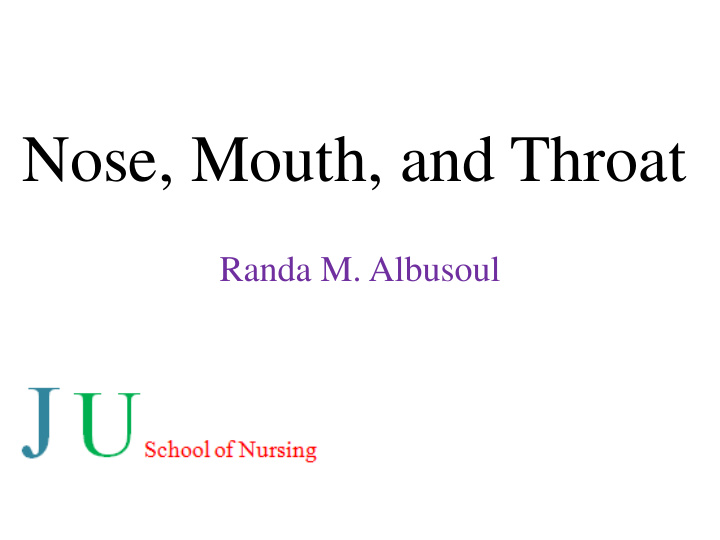



Nose, Mouth, and Throat Randa M. Albusoul
Anatomy Structure of the Nose: Function of the nose: 1- a site of inspiration and expiration. 2- filters, warms, and adds moisture to the air exchanged. 3-sensory organ for smell. 4-a site of speech resonance.
The nasal septum is well covered by the mucous membrane supplied with blood.
• Lateral walls of each nasal cavity contain 3 parallel bony projectons- superior, middle, and inferior turbinates. • Increase surface area so more blood vessels and mucous membranes are available to warm, humidify, and filter the inhaled air.
Paranasal sinuses: • Air-filled cavities within the bones of the skull. • Lined with mucous membranes. • Make the skull lighter and add to speech resonance. • Frontal and maxillary sinuses are only sinuses that can be examined by physical exam. • Most of paranasal sinuses drain in middle meatus.
Subjective Data Concerning symptoms of the nose are: Rhinorrhea Congestion Epistaxis Change in sense of smell Pain The opening questions may be: How is your breathing? Have you notice any change in your nose/ smell?
Rhinorrhea: runny nose; drainage - discharges from the nose. #Often comes with congestion (difficulty breathing through nose due to occlusion - obstruction); sense of stiffness. #These symptoms may come with sneezing, watery eyes, or throat discomfort, and are indication of infections, colds, or allergies.
Congestion: Is congestion associated with fever? Is it limited to one side? If yes….there may be a serious problem. Any surgery at that side? Old polyps? Injury? May be related to deviated nasal septum, foreign body, or tumor.
Foreign Furun Body cle
Epistaxis (bleeding from the nose): The blood usually comes from the nose, but may be caused by paranasal sinus or nasopharynx. In addition, the blood may be coughed up or vomited. Hemoptysis: is coughing blood or blood stained sputum, from the bronchi, larynx, trachea, or lung. Hematemesis: vomiting of blood, causes by upper gastrointestinal tract.
Assignment 1 What is first aid (emergency treatment) for bleeding nose?
Past history: Family history: Sinus infections Allergies Upper respiratory Asthma infections Cancer of the nose or sinus Allergies Trauma Nasal or sinus surgery Polyps Lifestyle habits: Dental history Air quality Any pets Tobacco use
Objective Data Inspect External nose: Nose-symmetric, in the midline, and in proportion to other facial features. Nasal cavity-normal red color, smooth and moist surface; you may see Middle and inferior turbinates- red color. Nasal septum-observe for deviation, inflammetion, note any bleeding or perforation. #For nasal obstruction press on each ala nasi and ask the patient to breathe. Note any ulcers or polyps-smooth, pale gray, and nontender.
Perforated nasal septum Tilt the patients head back when inspecting
Nasal mucosa: color, swelling, bleeding, exudates (discharges). If exudate is present note it character: clear or purulent. Palpate for sinus tenderness: press up for the frontal sinuses from under the bony brows.
Anatomy Structure of the mouth: • Color of the gingiva differ pale-pink in lighter- skinned people and brown in darker-skinned people. • Labial frenulum connect each lip with the gingiva.
• Tonsils are small or absent in adults .
• Lingual frenulum connect the tongue to the floor of the mouth. • Parotid duct open onto the buccal mucosa.
• There are 32 adult teeth, 16 in each jaw.
Subjective Data Concerning symptoms of the mouth are: Sore throat Hoarseness Lesions Sore tongue Bleeding gums Toothache Dysphagia Open questions may be: Have you notes any changes in your mouth/throat? Have you had any difficulty eating? Swallowing?
Hoarseness: altered quality of the voice; often described as rough or harsh. Main causes inflammation or infection of the larynx. Dysphagia: difficult in swallowing. Past history: Sore throat Loss of voice Mouth surgery Trauma, injury Oral cancer infections
Lifestyle habits: How many times do you brush your teeth? Floss? Do you smoke? Drink a lot of coffee?
Objective Data Remove the dentures if available: inspect and palpate the place of the dentures; look for ulcers or inflammation. Lips: color, moisture, integrity. Oral mucosa: color, ulcers, white patches… Gums: color, lesions, swelling, bleeding, discharge. Teeth: any missing, discolorations, cavities, misshape, abnormal positioning, loosing . The roof of the mouth: color, hard palate. Tongue: ask to pull out his tongue, inspect the symmetry (hypoglossal nerve)
Inspect the tongue for reddened areas, nodules, ulcerations.
Pharynx: ask the patient to say “ah” or press the tongue blade firmly down on the tongue. Note raising of the soft palate and uvula. (this is test for vagal nerve; CN X)
Inspect for tonsillar enlargement: +1: tonsils are visible +2: tonsils are between the tonsillar pillars and the uvula +3: tonsils are touching the uvula +4: tonsils are touching each other.
Recommend
More recommend